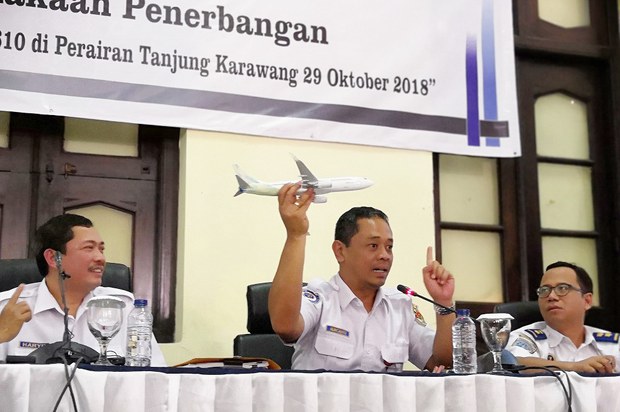Indonesian Officials: Lion Air Jetliner Was Unfit to Fly
2018.11.28
Jakarta
 National Transportation Safety Committee investigator Nurcahyo Utomo (center) gestures during a news conference in Jakarta to announce a preliminary report on the Lion Air crash, Nov. 28, 2018.
National Transportation Safety Committee investigator Nurcahyo Utomo (center) gestures during a news conference in Jakarta to announce a preliminary report on the Lion Air crash, Nov. 28, 2018.
A Lion Air jetliner that crashed into the sea with 189 people on board was not airworthy and should have been grounded prior to its deadly flight, Indonesian investigators said Wednesday.
The Boeing 737 MAX 8 plummeted into the Java Sea about 11 minutes after takeoff from Jakarta's Soekarno-Hatta International Airport on Oct. 29. Everyone on board was presumed dead.
“In our view, the plane was not airworthy and the flight (from Bali to Jakarta) should have not been continued,” crash investigator Nurcahyo Utomo told a news conference as Indonesia’s National Transport Safety Committee (KNKT) released its preliminary report on the probe.
“Several problems occurred at the same time, including a severe one where the aircraft was about to experience a stall or a loss of the lift," Nurcahyo said. “There should have been special treatment if a problem occurs several times in a short period of time.”
KNKT said in its report that the aircraft had shown incorrect airspeed and altitude readings on the previous flight from Bali to Jakarta, the night before it crashed.
The pilots turned off the stabilizer trim switches after the aircraft experienced the automatic nose-down trim and flew the remainder of that flight without the autopilot, the report said.
Lion Air CEO Edward Sirait debunked the report about the plane’s airworthiness.
“The aircraft was airworthy, according to documents from our technicians,” Sirait told a news conference.
“With regard to this statement, we will seek clarification from the KNKT in writing,” adding that the company was not ruling out legal action.
The report said maintenance logs for the aircraft recorded airspeed and altitude reading problems on each of the four flights that occurred over the three days before the flight that crashed.
But the issues persisted despite the logs indicating that that various maintenance procedures were performed, including the replacement of an Angle of Attack sensor, it said.
The report did not determine the cause of the crash. A final report on the investigation is expected later next year.
Nurcahyo said the pilots of the doomed flight struggled to regain control of the aircraft.
The crew tried to pull the aircraft back up repeatedly as the aircraft's automatic nose-down trim was activated, Nurcahyo said.
"This sequence repeated for the rest of the flight until the flight data recorder stopped recording," Nurcahyo said.
A feature in the Boeing aircraft, known as the maneuvering characteristics augmentation system (MCAS), has been installed by Boeing on its latest generation of 737s to prevent the aircraft's nose from getting too high and causing the aircraft to stall.
Investigators are looking into the possibility that the system might have forced the nose down after receiving erroneous information from sensors.
‘A deadly game of tag’
Peter Lemme, an aviation expert and a former Boeing engineer, likened the pilots' struggle to pull the aircraft’s nose back up to “a deadly game of tag.”
"The prior flight showed similar behavior. But on that flight, the flight crew appear to have quickly cutout the electric trim altogether, and completed the flight trimming the stabilizer with the wheel," Lemme wrote in his blog on Nov. 23.
Nurcahyo said the KNKT did not have enough information about the feature.
"This is another issue we will discuss with Boeing when we visit their facility. Why was this information not in the manual and why did the FAA (U.S. Federal Aviation Authority) approved the manual?" he said.
In its preliminary report, KNKT recommended that Lion Air "improve the safety culture" and empower pilots to make a proper decision on whether to continue a flight.
It also urged the airline to ensure that all documents are properly filled.
Boeing said after the preliminary report was released that safety was its top priority.
“As our customers and their passengers continue to fly the 737 MAX to hundreds of destinations around the world every day, they have our assurance that the 737 MAX is as safe as any airplane that has ever flown the skies,” the company said.
Boeing said it was “taking every measure to fully understand all aspects of this accident.”
Last month's crash was the second deadly accident involving a Lion Air plane in 14 years.
In 2004, the budget airline's McDonnell Douglas MD-82 overshot the runway of the airport in the central Java city of Solo and crashed into a cemetery, killing 25 people.
Nine years later, a Lion Air Boeing 737 carrying more than 100 people crashed into the sea while trying to land on Bali island, almost splitting the fuselage into two. There were no fatalities.







